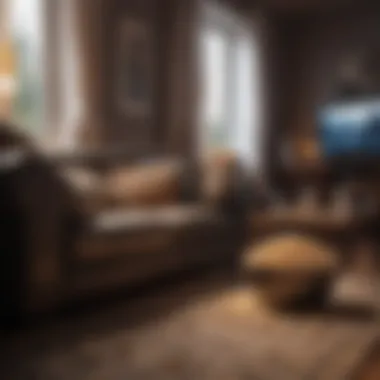Mastering the Art of Enjoying Scary Movies


Intro
Scary movies hold a unique place within the cinematic landscape. They attract audiences with the promise of thrills and chills, allowing viewers to confront their fears from the safety of their living rooms or movie theaters. As horror films continue to evolve, it's vital to understand how to enhance the overall experience of watching them. This exploration aims to provide tips that can elevate the viewer's enjoyment, making the encounter more resonant and impactful.
This article will outline effective preparation steps, viewing techniques, and the psychological dynamics at play in horror film experiences. By understanding these elements, viewers can better appreciate the genre, whether they are casual fans or seasoned enthusiasts. Beyond mere scares, there are deeper themes in horror that reflect societal fears and human emotion, making this genre rich with cultural significance.
In addition, realizing the appeal of horror films involves examining current trends, understanding viewer psychology, and discovering ways to create an immersive atmosphere. As we dive into the essentials for enjoying scary movies, these aspects will unfold and provide a thorough guide to maximizing engagement with this exciting genre.
Prelude to Horror Cinema
Understanding the core of horror cinema is essential for anyone seeking to enjoy scary movies. Horror films serve not just as a source of entertainment, but also as an intriguing exploration of the human psyche. They tap into our deepest fears and, in doing so, offer a reflective examination of societal anxieties and personal vulnerabilities.
Engaging with horror cinema is about more than simply watching a film; it is about connecting with emotions and settings that evoke fear. This genre holds a unique place in film history, providing a lens through which we can analyze cultural contexts and psychological themes.
Historical Overview of Horror Films
Horror cinema has evolved significantly since its inception in the late 19th century. Early films, like Le Manoir du Diable (1896), laid the groundwork for the genre by introducing supernatural elements and a sense of dread. As the decades progressed, horror adapted to societal changes, with films like Psycho (1960) and Night of the Living Dead (1968) reflecting the prevailing fears of their times, such as violence and mortality.
By the late 20th century, slasher films gained popularity, bringing a new kind of terror to the screen through graphic violence and memorable killers. The emergence of psychological horror expanded the genre, allowing filmmakers to explore the complexities of the human mind. Contemporary horror films, such as Get Out (2017), continue to challenge conventions, delving into social commentary while combining various elements from past sub-genres, keeping the genre fresh and relevant.
The Psychology of Fear
The experience of fear is deeply rooted in psychological responses, and horror films capitalize on this complex emotion. Fear triggers the fight-or-flight response, releasing adrenaline and leading to heightened sensations. Viewers may find themselves on edge, feeling a disconnect between their perceived safety and the threats presented on screen.
Additionally, horror films compel viewers to confront their fears in a controlled environment. This allows psychological exploration without real-world consequences. For many, horror serves as a cathartic experience, offering a safe space to engage with themes of death, anxiety, and the unknown. Such exploration can enhance emotional resilience, making the viewing experience impactful and memorable.
Engaging with horror films not only entertains but stimulates thought about our fears and how we manage them in daily life. This duality of enjoyment and introspection is pivotal for anyone looking to enjoy scary movies.
Preparing for a Scary Movie Marathon
Preparing for a scary movie marathon is crucial for maximizing enjoyment and minimizing discomfort. This preparation can transform a simple viewing experience into an engaging and memorable event. The right atmospheric elements, along with thoughtful film selection, can make all the difference in how one reacts to horror on-screen.
Creating the Right Atmosphere
Creating an appropriate atmosphere sets the stage for an immersive experience. The ambiance can significantly enhance tension and build excitement, making the viewer more susceptible to the film's scares.
Lighting Considerations
When viewing horror films, lighting plays a pivotal role. Dimming the lights creates shadows and adds to the suspense. A key characteristic of this approach is the balance between visibility and an eerie environment. Low light can amplify tension but can also lead to straining the eyes if overdone. A gentle flickering candlelight might enhance the spooky mood without entirely sacrificing comfort. Thus, this approach is popular among horror movie enthusiasts aiming for an immersive experience.
Choosing the Right Soundtrack


The soundtrack of a horror film is vital for building an unsettling atmosphere. The sound elevates emotions, enhancing the impact of the visuals. A distinctive quality of a haunting score is its ability to provoke fear even when nothing on-screen seems threatening. This choice can be beneficial because a well-curated soundtrack can prepare you for the film's twists. However, it can also be disadvantageous if too loud or jarring, causing unnecessary distraction from the narrative.
Selecting Comfortable Seating
Comfort during a movie marathon is not to be overlooked. Choosing the right seating ensures prolonged viewing without physical discomfort. A key advantage of comfortable seating is that it allows individuals to immerse themselves more fully in the film without the annoyance of adjusting frequently. Utilizing soft cushions or reclining chairs can enrich the viewing experience. However, it's important to avoid overly plush furniture that may make viewers sleepy at crucial moments.
Choosing the Right Films
Selecting suitable films is perhaps the most critical element of preparation. Different films evoke varying levels of fright and different emotional responses, and understanding your choices is key.
Analyzing Sub-genres
Horror comes in various sub-genres like psychological horror, slasher, and supernatural thrillers. Analyzing these sub-genres can greatly enhance ones viewing experience. The unique feature of sub-genres is their ability to cater to different attitudes towards horror. This analysis can be beneficial as it helps tailor selections to personal preferences, potentially leading to a more enjoyable marathon. Yet, there might be pitfalls if the selection does not align with viewers’ preferences, leading to a less enjoyable experience.
Consideration of Personal Tolerance for Scares
Personal tolerance for scares is essential when selecting films. This consideration involves understanding one’s limits regarding what content is frightening. A significant characteristic of this approach is its focus on individual comfort levels. Recognizing how much horror one can handle can lead to better film choices. However, the downside can come from restricting oneself too much, sacrificing the opportunity to explore new and potentially enjoyable experiences in the horror genre.
"Knowing your boundaries with horror films is as important as understanding the content of the films themselves."
Techniques for Enhancing the Viewing Experience
Enhancing the viewing experience of scary movies requires thoughtful consideration of several techniques. This section focuses on the mindset adjustments and the communal aspects of watching horror films. Both elements not only improve enjoyment but also deepen the connection to the genre. By preparing mentally and involving friends during the movie, viewers can amplify their experiences.
Mindset Adjustments
Embracing Vulnerability
Embracing vulnerability is about accepting that fear is a natural reaction to horror. This choice opens the door to a range of emotions. Allowing oneself to feel fear can lead to a more immersive experience. The key characteristic of this approach is recognition. Accept that it’s alright to feel fear and not shy away from it. This acceptance brings about a cathartic release, which can be refreshing.
The unique feature of embracing vulnerability lies in how it aligns viewers with the protagonists' experiences. When you feel vulnerable, you can connect more deeply with the characters’ struggles. This connection can enhance the emotional weight of the story. However, opening up to vulnerability may lead to discomfort for some. It might encourage viewers to confront their own fears, which can be both a disturbing yet transformative aspect.
Building Anticipation
Building anticipation is a strategic technique in horror movie watching. The thrill of waiting for the next scare often enhances the overall enjoyment. This approach cultivates excitement and keeps viewers engaged. One key characteristic of anticipation is its ability to heighten anxiety. The longer you wait for a scare, the more significant its impact when it finally occurs.
The unique feature of this technique is its emphasis on pacing. Building anticipation through subtle cues or foreshadowing allows viewers to prepare mentally for what’s to come. This method can amplify the satisfaction of the tension payoff. However, overdoing this can lead to viewer fatigue, making it essential to strike a balance.
Engaging with Friends
Group Dynamic Effects
The group dynamic effects of watching horror movies are profound. Engaging with friends creates a shared experience, which can enhance the thrill. The key characteristic of this dynamic is the collective response. Laughter, gasps, and screams become intensified within a group, making the viewing more enjoyable. It feels less isolating, which can be comforting.


A unique aspect of these dynamics is how they allow for shared processing of fear. Discussing scares with friends immediately after a scene often clarifies emotions. However, the group dynamic can have drawbacks. Overwhelming reactions might detract from personal enjoyment. This is especially true if not everyone has the same tolerance for scares.
Discussion and Reflection
Discussion and reflection after viewing a horror film are crucial for enjoyment. Talking about themes, scares, and characters can deepen appreciation for the genre. A key characteristic of this engagement lies in how it encourages critical thinking. Reflecting on plot elements increases understanding and connection to the film.
A notable feature of this technique is how it allows viewers to process feelings. After a frightening experience, discussing emotions can lead to a sense of closure. Yet, not all viewers find reflection helpful. Some might prefer to leave the experience unexamined, focusing instead on the thrill alone.
"Together, horror films enhance our understanding of fear and its psychological play, making the experience richer and more meaningful when shared."
Understanding Horror Tropes
Understanding horror tropes is essential for both casual viewers and dedicated fans of the genre. Tropes, as familiar patterns or themes in storytelling, serve multiple purposes. They can evoke specific emotional responses, build tension, and even provide a framework through which audiences interpret the narrative. Acknowledging these motifs allows viewers to appreciate the depth and creativity involved in horror cinema.
By recognizing common conventions, the audience can engage more critically with the film. This knowledge enhances their viewing experience and often heightens the thrill of recognizing subversions of these well-known archetypes.
Common Horror Archetypes
Horror films often utilize a set of character archetypes that audiences have come to expect. These roles can provide immediacy, allowing viewers to connect with characters upon first sight. Here are some prevalent archetypes:
- The Final Girl: A trope often seen in slasher films where the last surviving female character confronts the killer. This character is typically depicted as virtuous and resourceful.
- The Innocent: This character represents naivety and often becomes a victim of the horror. Their vulnerability elicits sympathy and fuels the narrative's stakes.
- The Skeptic: Usually a character that doubts the supernatural occurrences until faced with undeniable evidence, their journey reflects the audience’s own skepticism.
- The Authority Figure: This character often represents societal order but may either fail or be overpowered by the chaos of the horror.
Understanding these archetypes allows viewers to predict behaviors and develop a concise understanding of the impending plot twists.
Meta-Horror and Self-Awareness
Meta-horror is a fascinating area within the genre. This concept includes films that acknowledge their own tropes, often playing with audience expectations. Movies like "Scream" demonstrate this by featuring characters who are well-aware of horror movie tropes, which they often debate and dissect ironically.
Self-awareness provides a refreshing twist, inviting viewers to not only be passive recipients of scares but also to actively engage with the film's commentary on the genre itself.
The relationship between meta-horror and its audience fosters a unique connection. Viewers who understand the humor and nuances of these films often find them more enjoyable. They can appreciate the layering of storytelling, where conventional scares coexist with a self-referential critique.
Coping with Fear After Viewing
Experiencing fear while watching a horror movie is a common aspect of the viewing experience. However, the feelings that linger post-viewing can be uniquely challenging. Understanding how to cope with these feelings is essential not only for enjoyment but also for one’s overall emotional well-being. The importance of this section is twofold: first, it facilitates a healthier relationship with fear and anxiety, and second, it provides the viewer with tools to manage and even embrace these feelings intelligently and consciously.
Decompressing Techniques
After the end credits roll, a sense of unease may often persist. Engaging in decompressing techniques can be effective. Here are some strategies to alleviate residual tension:
- Deep Breathing: Focus on slow, deep breaths. Inhale slowly through the nose, hold for a few moments, and exhale through the mouth. This helps center the mind.
- Physical Activity: Going for a walk or engaging in light exercise can release pent-up energy and stress, allowing the body to return to its normal state.
- Diverging Interests: Shifting attention to something light can help. This could be watching a sitcom, reading a book, or listening to uplifting music.


These methods serve to ground a person, allowing hobbies and daily life to take precedence again.
Discussing Themes and Reactions
Discussion can play a vital role in processing the emotional impact of a horror film. Sharing thoughts with friends or online communities facilitates the exploration of themes present in the movie. Here are aspects worth considering:
- Understanding Themes: Delve into what the film was trying to portray. Many horror movies reflect deeper societal fears or personal anxieties. This unpacking can lead to sociological insights.
- Sharing Reactions: Conversations about individual reactions to the movie can highlight the diversity of perspectives. It is important to acknowledge that everyone processes fear differently.
- Relatable Experiences: Engaging with others’ reactions helps create a community feeling, diminishing the isolating effect of fear.
A good discussion often transforms an unsettling experience into a learning opportunity. Online forums like Reddit may offer an excellent platform for exploring different interpretations and reactions.
"Talking about fears openly helps in disarming them. Sharing brings catharsis that solitary digesting may lack."
These practices are valuable. They not only help negate fear but also enhance enjoyment for future viewings.
Exploring the Cultural Impact of Horror Cinema
Horror cinema is more than just a means of entertainment; it serves as a mirror reflecting societal fears and anxieties. The importance of exploring this cultural impact cannot be overstated, as it allows viewers to understand the deeper implications behind the genre. Scary movies frequently tackle issues that resonate with their audiences, making them a powerful vehicle for social commentary and emotional exploration.
Reflections of Societal Fears
Horror films often embody the collective fears of the time. The themes portrayed in these movies provide insight into what societies grapple with, whether it be external threats or internal disruptions. For example, during times of political upheaval, horror films might feature themes of distrust or alienation. This generates a dialogue around societal issues that may be difficult to address in everyday conversations.
Taking a look at iconic films like "Night of the Living Dead", we see how it reflects the racial tensions of the late 1960s, or "Get Out", which tackles contemporary issues related to race and identity. Such films compel audiences to confront uncomfortable truths. Or, consider the rise of technological fears in movies such as "The Terminator". Here, the dread regarding uncontrolled technological advancement resonates distinctly with public sentiment.
This reflective nature of horror cinema leads us to a greater understanding of societal dynamics, often compelling viewers to rethink their perspectives and beliefs about the world.
The Role of Horror in Social Commentary
Horror does more than evoke fear; it challenges audiences to engage with pressing societal issues. Many horror films serve as a platform for social critique. They often comment on themes such as discrimination, gender roles, and environmental concerns. By exaggerating fears, horror movies can reveal underlying truths in a manner that is both engaging and unsettling.
Take, for example, the film "A Nightmare on Elm Street". This film doesn't just present a killer; it also serves as a commentary on the trauma of adolescence and parental fears. It demonstrates how horror can relate personal terror to broader social phobias. Similarly, films like "The Babadook" articulate grief and depression in a narrative that frightens and resonates with many viewers.
Finale
The conclusion of this article underlines the significance of the enduring appeal of scary movies. Horror films hold a unique position in cinematic culture, inviting viewers to confront and explore human fears and emotions. The cathartic experience offered by fear can incite a range of responses that contribute to our emotional health.
The Enduring Appeal of Scary Movies
The fascination with scary movies lies in their ability to captivate a diverse audience. They offer not just thrills but insights into the darker aspects of the human psyche. Engaging with horror invites viewers to suspend disbelief and surrender to the tension building on-screen.
Moreover, horror engaged audiences can identify with characters that face unimaginable odds. This relatability intensifies the experience as people often find comfort in shared fear. Scary movies can provide a safe environment to confront anxiety, allow self-reflection and improve coping strategies.
"Horror films are not merely exercises in shock value, they can also provoke thoughtful discussions regarding societal issues and personal fears.”
As highlighted prior, the genre's versatility means there are films for all preferences and tolerance levels. Personal growth is achieved through engagement with the medium, guided by the emotions elicited during viewings.
Engaging with scary films also fosters community. Whether shared among friends or discussed in online forums like reddit.com, horror creates an environment where viewers can bond over their shared experiences. This social aspect enriches the overall enjoyment and encourages diverse interpretations of films.
In summary, the appeal of scary movies transcends simple entertainment. It opens pathways to explore and understand fears while promoting connections among viewers. Their significance in our culture is undeniable, advocating for the continued appreciation and exploration of horror cinema.



